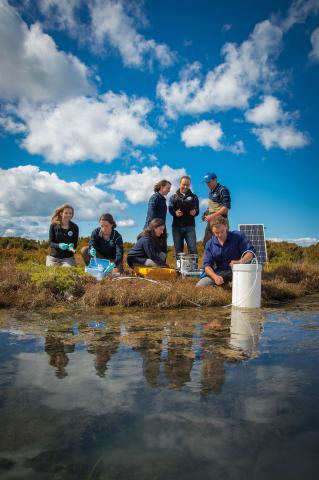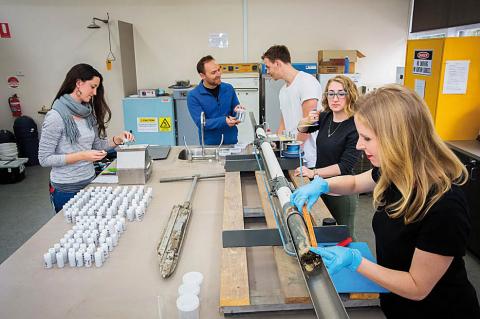While blue-carbon scenarios abound, investment hinges on the details – including the development of a rigorous, internationally accepted accounting system
By Bianca Nogrady

Peter Macreadie and PhD candidate Ashley Whitt measure a blue-carbon core taken from a mangrove swamp at Stony Creek, beneath Melbourne’s West Gate Bridge.
Photo: Donna Squire, Deakin University
The term ‘carbon farming’ usually conjures images of land-based agricultural and forestry initiatives. But there’s a new kid on the carbon-farming block, and it occupies the rich ecological niches that hug Australia’s extensive coastline.
As an island nation, Australia boasts one of the longest coastlines in the world: nearly 60,000 kilometres in total. While some of that coastline is occupied by beaches, large swathes are also home to mangroves, saltmarshes and seagrass beds. These are the sources and sinks for ‘blue carbon’ – the carbon stored in coastal marine sediments and plants.
Former Federal Environment Minister Greg Hunt advanced the concept of blue carbon at the 2015 United Nations Climate Change Conference in Paris. Since then, interest has been growing in how Australia can capitalise on this carbon resource – and, in doing so, help restore ecosystems that are also vital for fisheries.
Australia was one of the first countries to include blue carbon in its National Greenhouse Gas Inventory, and was instrumental in launching the International Partnership for Blue Carbon at the Paris climate conference.
For fisheries, blue-carbon initiatives could offer multiple benefits. They could address climate change and ameliorate the related flow-on effects to fisheries, as well as improve, restore and protect critical fishery habitats.
Boutique carbon

Researchers from Deakin University’s Blue Carbon Lab use a multi-pronged approach to understanding blue-carbon dynamics.
Photo: Donna Squire, Deakin University
Blue carbon can be thought of as ‘boutique’ carbon, says Catherine Lovelock, professor in the School of Biological Sciences at the University of Queensland, because it offers so much more than simple carbon sequestration.
“We can plant a mallee forest, and maybe we’ll help some biodiversity, but mangroves are habitat and nursery for many commercially valuable coastal marine species, including Mangrove Jack, Barramundi, Mud Crabs and Banana Prawns, as well as being home to molluscs and other crustaceans,” she says. “Mangroves also act as a buffer zone to protect against storm surges and extreme events, such as cyclones and tsunamis.”
Blue carbon also has far greater capacity than land-based carbon, says CSIRO marine ecologist Mat Vanderklift. In a typical land-based scenario, the availability of oxygen speeds up the decomposition of organic matter. Some of the carbon is sequestered in the soil, and some is taken up by trees and plants; but much of it soon returns to the atmosphere.
In contrast, the soils of mangroves, saltmarshes and seagrasses exist in a low-oxygen, wet, salty environment. Decomposition is much slower, and the carbon is locked into the sediment at far greater rates.
“We’ve cored into seagrass meadows and they can be thousands of years old,” says Mat Vanderklift. This means these marine soils also accumulate far more carbon than soils on land.
“We’ve got two to three metres deep of old seagrass or old mangrove, and that’s basically thousands of years’ worth of carbon locked away,” he says.
Blue-carbon farming
Blue carbon is of particular interest to the Queensland Government’s Land Restoration Fund – a $500 million initiative set up specifically to expand carbon farming, with a focus on projects that also deliver environmental and economic benefits. The fund is set to announce the results of its first round of pilot project funding early this year. Don Butler, a scientist working on the fund, says this is likely to include blue-carbon projects.
“There’s a recognition that the carbon market can be used to change the economic frame around land restoration,” he says. “When you think about what kind of land restoration is in the interests of Queensland, coastal land restoration definitely is.”
One scenario for blue-carbon development is removal of bunds – or earthen walls – that block tides from entering estuarine saltmarshes. Since European settlement, thousands of bunds have been built by pastoralists up and down the Queensland coast to keep out salt and create ponded freshwater pastures in which cattle can graze.
A 2017 CSIRO report identified the introduction of tidal flow back into mangroves and tidal marshes as a significant blue-carbon farming opportunity. This is not just in terms of the carbon sequestration that could then take place in the estuarine soils, but also in the avoided emissions from removing methane-producing freshwater pastures.
“That fits with the Land Restoration Fund’s broader purpose, which is about land restorations, and that type of activity is about restoring estuarine wetland, which has fisheries benefits as well,” Don Butler says.
Another blue carbon-farming scenario involves avoiding the disturbance and degradation of coastal ecosystems. Peter Macreadie, associate professor of Environmental Science and head of the Blue Carbon Lab at Deakin University, describes one project working with cattle farmers to fence off shorelines. This prevents the cattle disturbing coastal soils and causing erosion.
“We’re hoping that a lot of these systems come back on their own, and we’ve got other areas where we know that they’ve been damaged over time, and we can go in and plant or encourage recovery,” he says.
Sea-level rise could also provide an opportunity for landowners along coastlines to work with the rising water, rather than be hampered by it.
“We could be planning to encourage sea-level rise to go into those areas and find new economic opportunities for landholders to be offset and compensated for the loss of land they have as a result of sea-level rise,” Peter Macreadie explains. “They’re actually farming mangrove forests, for example, instead of cattle.”
Roadblocks to blue-carbon trading

Paul Carnell and Peter Macreadie use a Russian peat corer to take a blue-carbon sample from a coastal site that has been earmarked for restoration.
Photo: Donna Squire, Deakin University
While the enthusiasm for blue carbon is clear, a few hurdles must still be overcome before Australia can start trading blue-carbon offsets on the carbon market.
The first is that Australia does not yet have an agreed method for blue-carbon accounting. This is something that must be established by the Australian Government’s Emissions Reduction Fund before blue-carbon trading can launch, Catherine Lovelock says.
“We can’t do carbon projects in Australia that don’t go through the Emissions Reduction Fund, because they’re worried about double-counting of carbon dioxide,” she says.
There’s no word on when that method will be finalised, but there’s a clear sense of impatience among those in the industry.
Another hurdle is that the science of blue-carbon accounting, while fairly advanced in Australia, still has some ‘known unknowns’. One of these is the question of whether seaweed fits within the blue-carbon portfolio.
Catherine Lovelock says that while seaweed ecosystems are highly productive, they do not necessarily sequester carbon long term.
“There’s no sediment accumulation. To be a carbon project, you have to work out how that seaweed gets to the bottom of the ocean and doesn’t come back out again as carbon dioxide.”
An even bigger challenge is accounting for the avoided emissions associated with turning methane-producing freshwater, ponded pastures back into carbon-sequestering saltmarshes and mangroves.
“We need to know how much methane that system is giving off, so that we can say, when we convert it, we’ve basically avoided that methane emission,” Catherine Lovelock explains. “That could double the value of our projects, because in some cases the carbon sequestration part might actually be quite small.”
Another question is how to map Australia’s blue-carbon resources, says Mat Vanderklift.
“Seagrasses live underwater and they’re not usually visible, so mapping them is a bit harder than mapping a mangrove, where we can use satellite-based methods,” he says.
And if blue carbon is to command a higher price as a ‘boutique’ product on the carbon market, there’s also a need to account for those additional environmental and social benefits.
“We’re looking at the social and livelihood benefits, so doing things like measuring what are the fishery benefits of a mangrove or a seagrass,” Mat Vanderklift says. “We know they’re there, but can we quantify them?”
Then there’s the question of who owns this potentially lucrative carbon resource. While the intertidal zone falls under the ownership of the state and federal governments, Rowan Foley, CEO of the Aboriginal Carbon Foundation, highlights the case of Blue Mud Bay in the Northern Territory – where the High Court recognised the rights of the Yolngu people over the intertidal zone in 2008.
“The mangroves and the seagrasses are largely in that intertidal zone, so the fact that native title rights have been demonstrated in that area is very good, because it opens up that whole door for us,” he says.
Catherine Lovelock suggests that carbon-farming operations on public land might operate under a similar model to aquaculture leases. Governments may not want to do these projects themselves, but may want to facilitate them.
“It’s just something a project would have to negotiate,” she says.
Offsetting with blue carbon

Sediment cores are extruded to determine blue-carbon content and the rate of sequestration.
Photo: Simon Fox, Deakin University
While so many blue-carbon initiatives are in the pilot stage, awaiting the development of an accounting method – and in some cases, hoping to inform that process – the fisheries industry is waiting for the chance to invest in blue carbon.
In 2016, Western Australia’s Austral Fisheries became the world’s first seafood sector company to become carbon neutral. Austral CEO David Carter says the company would have preferred to go with blue-carbon offsets, with the potential to benefit coastal and estuarine ecosystems and fisheries, but the methodology to do so had not been adequately developed at that time.
Bryan Skepper, general manager of the Sydney Fish Market, says the market has already achieved a 17.8 per cent reduction in its carbon emissions and attained carbon-neutral status. It is now working towards a target of 20 per cent reduction by 2020, in partnership with Qantas and the Future Planet program.
But the Sydney Fish Market’s ultimate aim is to offset its carbon emissions with blue carbon. A blue-carbon working group the market is participating in has already applied for funding for a blue-carbon project on the Mossman floodplain and Burdekin delta in Queensland.
“If companies start to invest in mangroves and seagrass beds, which are the nurseries for the fish we harvest, then we get a double win out of it,” Bryan Skepper says. “We’re not only offsetting our carbon; we’re creating habitat or rehabilitating habitat that enables the fish stocks to breed, which if you’re really successful with it, enables the sustainable catch rates to increase.”
Taking steps towards carbon-neutral fisheries
In 2017, participants in the National Seafood Industry Leadership Program challenged the seafood sector to become carbon neutral by 2030.
In response, the FRDC and CSIRO hosted a workshop in July 2018 that invited representatives from industry, government and non-government organisations to discuss the challenges and opportunities around achieving carbon neutrality – with an emphasis on blue-carbon offsets.
The workshop identified several steps that could help the seafood sector move towards becoming carbon neutral:
- Develop and deliver sector-relevant resources that outline the benefits of carbon neutrality, the various options to achieve it, and how to go about it.
- Engage with carbon market organisations and standards providers to ensure that ‘scene-setting’ activities related to carbon abatement, such as data collection and standards development, are relevant to the seafood sector.
- Connect with organisations and initiatives already working towards carbon neutrality through both land-based and blue-carbon offsets in Australia and around the world, with the aim of establishing future seafood sector projects.
For fisheries and seafood businesses looking to take the first step towards becoming carbon neutral, both the Queensland Seafood Industry Association and the UK peak body Seafish have developed online emissions calculators.
For more details, the full workshop report can be found here.
FRDC Research Code: 2018-060
More information
Mat Vanderklift
mat.vanderklift@csiro.au
Nicole Stubing
nicole.stubing@frdc.com





